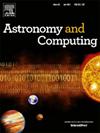Africanus I. Scalable, distributed and efficient radio data processing with Dask-MS and Codex Africanus
IF 1.8
4区 物理与天体物理
Q2 ASTRONOMY & ASTROPHYSICS
引用次数: 0
Abstract
The physical configuration of new radio interferometers such as MeerKAT, SKA, ngVLA and DSA-2000 informs the development of software in two important areas. Firstly, tractably processing the sheer quantity of data produced by new instruments necessitates subdivision and processing on multiple nodes. Secondly, the sensitivity inherent in modern instruments due to improved engineering practices and greater data quantities necessitates the development of new techniques to capitalize on the enhanced sensitivity of modern interferometers.
This produces a critical tension in radio astronomy software development: a fully optimized pipeline is desirable for producing science products in a tractable amount of time, but the design requirements for such a pipeline are unlikely to be understood upfront in the context of artefacts unveiled by greater instrument sensitivity. Therefore, new techniques must continuously be developed to address these artefacts and integrated into a full pipeline. As Knuth reminds us, “Premature optimization is the root of all evil”. This necessitates a fundamental trade-off between a trifecta of (1) performant code (2) flexibility and (3) ease-of-development. At one end of the spectrum, rigid design requirements are unlikely to capture the full scope of the problem, while throw-away research code is unsuitable for production use.
This work proposes a framework for the development of radio astronomy techniques within the above trifecta. In doing so, we favour flexibility and ease-of-development over performance, but this does not necessarily mean that the software developed within this framework is slow. Practically this translates to using data formats and software from the Open Source Community. For example, by using NumPy arrays and/or Pandas dataframes, a plethora of algorithms immediately become available to the scientific developer.
Focusing on performance, the breakdown of Moore’s Law in the 2010s and the resultant growth of both multi-core and distributed (including cloud) computing, a fundamental shift in the writing of radio astronomy algorithms and the storage of data is required: It is necessary to shard data over multiple processors and compute nodes, and to write algorithms that operate on these shards in parallel. The growth in data volumes compounds this requirement. Given the fundamental shift in compute architecture we believe this is central to the performance of any framework going forward, and is given especial emphasis in this one.
This paper describes two Python libraries, Dask-MS and codex africanus which enable the development of distributed High-Performance radio astronomy code with Dask. Dask is a lightweight Python parallelization and distribution framework that seamlessly integrates with the PyData ecosystem to address radio astronomy “Big Data“ challenges.
使用Dask-MS和Codex Africanus进行可扩展、分布式和高效的无线电数据处理
MeerKAT、SKA、ngVLA和DSA-2000等新型无线电干涉仪的物理配置为两个重要领域的软件开发提供了信息。首先,处理新仪器产生的大量数据需要在多个节点上进行细分和处理。其次,由于改进的工程实践和更大的数据量,现代仪器固有的灵敏度需要开发新技术来利用现代干涉仪增强的灵敏度。这在射电天文学软件开发中产生了一个关键的紧张关系:一个完全优化的管道是在可处理的时间内生产科学产品的理想选择,但是在更高仪器灵敏度揭示的人工制品的背景下,这种管道的设计要求不太可能被预先理解。因此,必须不断开发新技术来处理这些工件,并将其集成到一个完整的管道中。正如Knuth提醒我们的,“过早优化是万恶之源”。这需要在三个方面(1)性能代码(2)灵活性和(3)易于开发)之间进行基本的权衡。一方面,严格的设计要求不太可能捕捉到问题的全部范围,而一次性的研究代码不适合生产使用。这项工作提出了在上述三方面发展射电天文学技术的框架。在这样做的过程中,我们更喜欢灵活性和易于开发,而不是性能,但这并不一定意味着在这个框架内开发的软件很慢。实际上,这意味着使用来自开源社区的数据格式和软件。例如,通过使用NumPy数组和/或Pandas数据框架,科学开发人员可以立即使用大量算法。关注性能,2010年代摩尔定律的崩溃以及由此带来的多核和分布式(包括云)计算的增长,需要对射电天文算法的编写和数据存储进行根本性的转变:有必要在多个处理器和计算节点上分片数据,并编写在这些分片上并行操作的算法。数据量的增长加剧了这一需求。考虑到计算架构的根本性转变,我们相信这是未来任何框架性能的核心,并且在本文中特别强调。本文介绍了两个Python库,Dask- ms和codex africanus,这两个库可以使用Dask开发分布式高性能射电天文代码。Dask是一个轻量级的Python并行化和分发框架,它与PyData生态系统无缝集成,以解决射电天文学“大数据”挑战。
本文章由计算机程序翻译,如有差异,请以英文原文为准。
求助全文
约1分钟内获得全文
求助全文
来源期刊

Astronomy and Computing
ASTRONOMY & ASTROPHYSICSCOMPUTER SCIENCE,-COMPUTER SCIENCE, INTERDISCIPLINARY APPLICATIONS
CiteScore
4.10
自引率
8.00%
发文量
67
期刊介绍:
Astronomy and Computing is a peer-reviewed journal that focuses on the broad area between astronomy, computer science and information technology. The journal aims to publish the work of scientists and (software) engineers in all aspects of astronomical computing, including the collection, analysis, reduction, visualisation, preservation and dissemination of data, and the development of astronomical software and simulations. The journal covers applications for academic computer science techniques to astronomy, as well as novel applications of information technologies within astronomy.
 求助内容:
求助内容: 应助结果提醒方式:
应助结果提醒方式:


